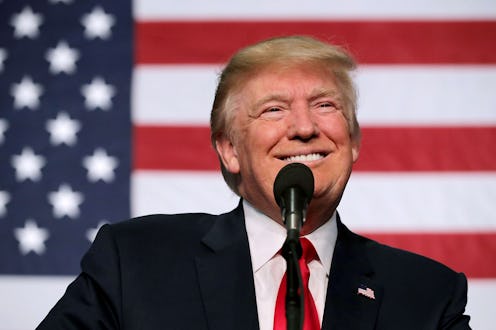News
This Giant Mural Of Trump Is The First Thing Migrant Kids See At Their Detention Center

The largest detention center for migrant children in Texas is currently housing over 1,500 children. And right at the entrance of the sprawling former Wal-Mart that now serves as temporary residence for a growing number of minors, detained children are greeted by a big mural of President Trump.
News of Trump's prominent placement was first reported by MSNBC correspondent Jacob Soboroff. Along with a handful of reporters, Soboroff was one of the first to gain admittance to the Casa Padre facility in Brownsville, Texas. It's the single largest migrant children's shelter in the nation, with Soboroff reporting that almost 1,500 boys aged 10-17 currently detained there.
The Casa Padre facility came to recent national attention, after Sen. Jeff Merkley attempted to tour the facility and was barred from entering the building. Merkley has argued that the United States Senate has the constitutional right to inspect federally run facilities, and his live-streamed video of being actively denied entry was viewed more than 1 million times on Facebook.
Roughly a week after Merkley's visit, facility personnel allowed a small group of journalists to tour the Casa Padre detention center, Soboroff among them. He wrote a series of tweets following his walk-through, noting the accompanying message on the giant mural of Trump: "Sometimes losing a battle you find a new way to win the war.”
Presidential murals are a common sighting throughout the Casa Padre detention center, but not all of them feature Trump. Video clips aired on MSNBC show one mural with President Obama, and more with other past U.S. presidents. Soboroff reports that detained children attend school for six hours a day — and one subject that gets special attention is American history.
Soboroff claimed on Twitter that migrant children detained at Casa Padre "are incarcerated." Their days are structured, with about two hours of time outside daily and mandatory lights out at 9 p.m. And it's unclear how often kids who were separated from their parents upon crossing the border are able to contact family members. As Soboroff told MSNBC host Lawrence O'Donnell, that depends on the prison policy where their parents are detained.
Soboroff also reported that, since the Office of Refugee Resettlement has become the temporary custodian of these children, some have been given medication for psychiatric distress and other symptoms (which are not uncommon in children who have experienced a trauma like parental separation). The decision to approve such drug use would usually be exclusively up to a child's parents.
As noted by Tom Llamas, an ABC News correspondent, most of the children at Casa Padre are unaccompanied minors, meaning they crossed the southern border without an adult. However, the facility has recently been pushed beyond its normal capacity by an uptick in children separated from their parents at the border.
That comes as a result of a new policy from the Trump administration to charge all immigrants who cross the border illegally with a federal crime. As Dara Lind reports at Vox, children are not allowed to be kept in federal incarceration, so they must be separated from their parents.
The policy has come under harsh criticism from many sectors. Sen. Kamala Harris tweeted Wednesday that tearing children away from their parents amounted to "human rights abuse." The ACLU has challenged the policy in court, with a measure of success. And the United Nations has made clear that it rejects any separation of children from their parents. The Trump administration has also detained certain immigrants who report at designated centers to file requests for asylum. Lind notes that the Obama administration also prosecuted some in similar circumstances, but that such a practice may be found unconstitutional by the judicial system.
For the migrant children housed at Casa Padre, one of their first encounters will be a mural depicting Trump — the president whose crackdown on illegal border crossings is the very reason they find themselves there in the first place.